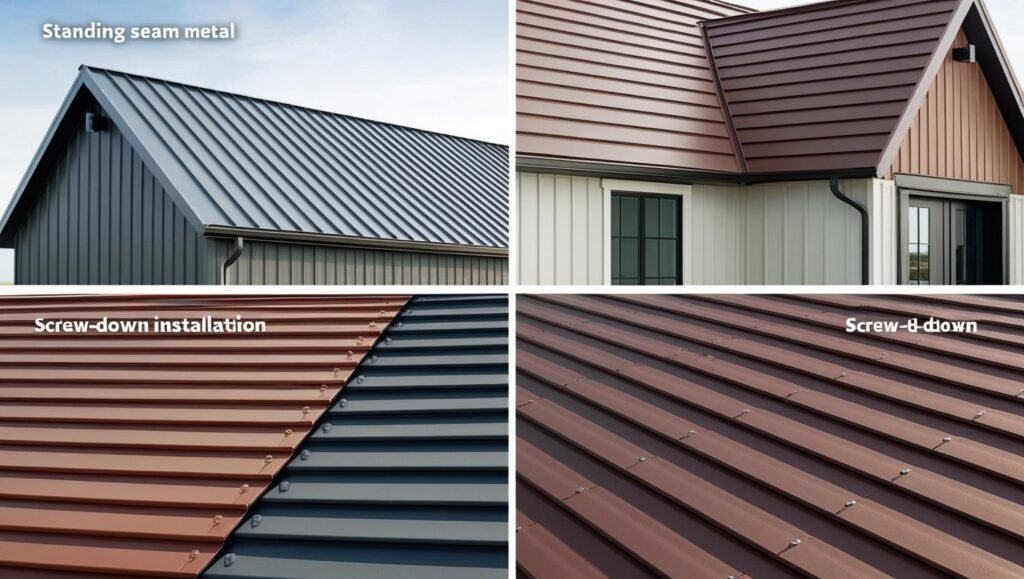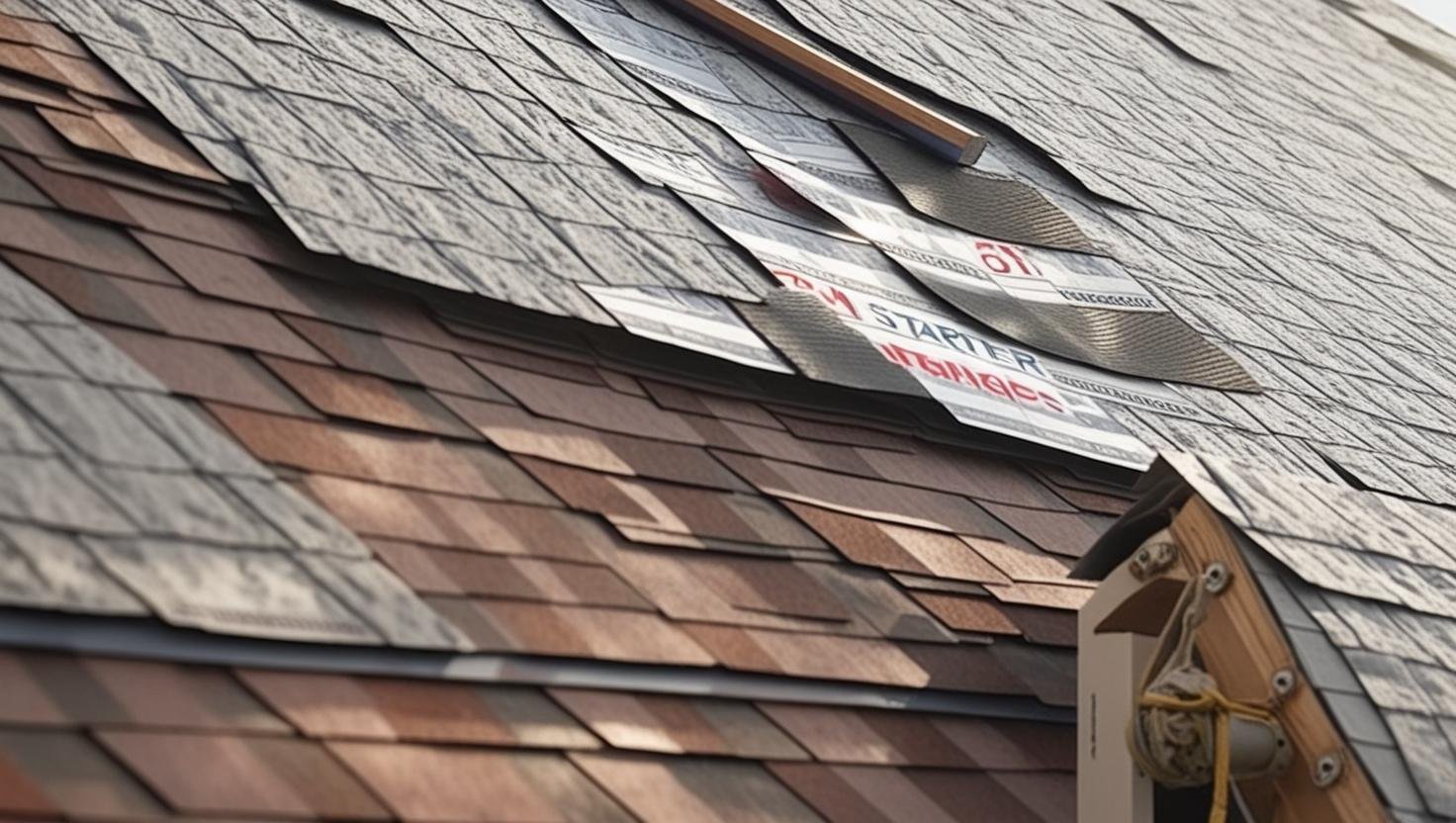Choosing Between Standing Seam and Screw Down Metal Roofs
Table of Contents
ToggleWhen it comes to a roof choice, metal is one of the strongest and most reliable options available. Two popular types of metal roof systems are standing seam and screw-down roofs. Each one has its own advantages, depending on your home’s design, your budget, and the style you’re aiming for.
After working on several homes myself and speaking with many roofers, I’ve learned just how important it is to understand both options before making a decision.
Let’s walk through it in a simple way.
What Are Standing Seam Metal Roofs?
Standing seam roofs feature sleek panels that connect at raised ribs, where the fasteners are hidden underneath. This gives the roof a clean, modern appearance. Instead of being screwed directly into place, the panels are attached with special clips that allow the metal to shift slightly with thermal expansion and contraction. This flexibility helps prevent damage over time.
Thanks to the hidden fasteners, standing seam roofs are highly weathertight, resist leaks, and perform well in strong winds. They’re typically made from steel, aluminum, or copper. While copper is more expensive, it develops a beautiful natural patina that adds incredible curb appeal. If you’re looking for a stylish, durable roof that can last up to 50 years with minimal maintenance, standing seam is definitely a top choice.
What Are Screw-Down Metal Roofs?
Screw-down roofs, also called exposed fastener systems, use visible screws and washers to secure the roof panels. You can easily spot the fasteners across the surface. This method is cost-effective and is commonly used for residential garages, barns, or sheds where appearance isn’t the top priority.
However, because the screws go straight through the metal, these roofs are more prone to fastener failure over time. As the roof expands and contracts with temperature changes, the screws can start to wallow or loosen, leading to leaks. To avoid bigger issues, screw replacement is usually needed every 5–10 years.
Made mostly from steel or aluminum, screw-down roofs can last around 20 years, or even 30 years with proper roof maintenance.
Materials and Durability of Metal Roofs
Both standing seam and screw-down systems use strong materials like steel, copper, stainless steel, and zinc.
- Steel is known for its strength.
- Aluminum is lighter and great for energy efficiency since it reflects sunlight.
- Zinc naturally develops a self-healing patina that hides small scratches and extends the roof’s life.
Choosing premium metals like copper or zinc can give you a roof that lasts between 30 and 50 years. Many metal roofs also come with a Kynar 500 painted finish that resists weathering and rust and keeps the roof looking sharp. This finish often comes with a paint warranty of 30 years.
For extra durability, it’s smart to select a thicker gauge metal (lower numbers like 22 gauge), offering better protection against hail, storms, and other harsh weather.
Key Differences: Standing Seam vs Screw Down
| Feature | Standing Seam | Screw Down |
| Fasteners | Hidden clips | Visible screws/washers |
| Aesthetic issue | Sleek, modern look | More industrial or rustic look |
| Durability | Handles thermal expansion easily | Higher risk of fastener failure |
| Lifespan | 30–50 years | 20–30 years (with maintenance) |
| Maintenance needs | Very low | Higher (requires screw replacement) |
| Cost | Higher upfront | Lower upfront |
| Wind resistance | Excellent (wind uplift protection) | Less resistant |
| Energy efficiency | Great | Good |
Cost, Installation, and Long-Term Value
In my experience helping homeowners choose roofing, installation often makes a huge difference.
Standing seam roofs require skillful installation because the hidden fasteners must be lined up precisely. This means higher labor costs, but the result is a strong, long-lasting roof.
Screw-down roofs are easier and cheaper to install, but they require more roof maintenance over time due to issues with loose screws and leaks. Over the years, the cost of repairs can add up.
When you consider the entire lifespan and how much it boosts your home’s ROI with better curb appeal and energy efficiency, standing seam roofs often offer better value long term.
Which Metal Roof Is Best for Residential Homes?
If you’re covering a heated area like your main living space, standing seam is the smarter investment. It handles thermal responsiveness better and avoids common problems like wavy patterns (oil canning) or loose fasteners.
If you’re roofing a garage, barn, or stone-coated outbuilding where aesthetic issues aren’t a major concern, a screw-down roof is a more cost-effective choice.
Either way, both types of roofs are fire resistant, durable against corrosion, and last far longer than standard asphalt shingles.

How Metal Roofs Impact Energy Efficiency and Comfort
Choosing a metal roof system isn’t just about strength and style — it also greatly affects your home’s energy use and comfort.
Metal roofs, especially those made from aluminum or steel with a Kynar 500 painted finish, reflect sunlight rather than absorbing it. This can significantly lower your cooling bills during hot months.
Standing seam roofs usually perform even better because their sleek panels and hidden fasteners reduce gaps where heat could slip through. Their design also helps prevent issues caused by thermal expansion.
Screw-down roofs still offer good reflection, but they may lose some efficiency if washers and screws loosen over time.
Tips to maximize energy savings:
- Choose lighter roof colors in hot climates.
- Use reflective materials like zinc or aluminum.
- Add proper insulation beneath the roof for year-round comfort.
From my experience, many homeowners are surprised by how much cooler and more comfortable their home feels once the new roof is installed — it’s a difference you notice right away.
Common Mistakes to Avoid with Metal Roofs
Now that you know how a metal roof can improve energy efficiency, it’s just as important to avoid mistakes that could shorten its life.
Here are key issues to watch out for:
- Improper Fastening:
Over-tightening screws in a screw-down roof can crush the washers, while loose clips in a standing seam roof can cause movement issues. - Ignoring Thermal Movement:
Without room for thermal expansion, panels and ribs can crack or leak. - Choosing the Wrong Materials:
Picking thinner metals (like 29 gauge) may seem cost-effective but leads to poor durability in bad weather. - Skipping Regular Maintenance:
Even standing seam roofs benefit from occasional checks, and screw-down roofs need scheduled screw replacement to prevent leaks. - Poor Debris Management:
Dirt, branches, and leaves trap moisture, speeding up corrosion. Regular cleaning protects your roof’s paint warranty and surface.
Catching small issues early can save you from major repairs later. A little care keeps your metal roof performing beautifully for decades.
Final Thoughts
Choosing the right metal roof system depends on what matters most to you: saving on upfront costs or saving time and maintenance later.
Standing seam roofs deliver high performance and sleek looks and can last up to 50 years with minimal upkeep.
Screw-down roofs are cheaper upfront but will need more regular attention as the years go by.
No matter which you choose, investing in a metal roof means investing in strength, style, and long-lasting protection for your home.
Metal Roofing Standing Seam vs Screw: (FAQs)
1. How often do screw-down metal roofs need maintenance?
Screw-down roofs typically require screw replacement every 5–10 years to prevent wallowing and leaks caused by thermal movement.
2. Can standing seam roofs handle strong winds?
Yes! Standing seam roofs offer excellent wind resistance and wind uplift protection, making them ideal for areas prone to storms.
3. Is there a risk of rust with metal roofs?
Not if you choose the right finish. A Kynar 500 painted finish protects against rust and weathering and often includes a 30-year paint warranty.
4. Which metal is best for energy efficiency?
Aluminum and zinc are great choices for energy efficiency because they naturally reflect more sunlight, keeping your home cooler.
5. Are metal roofs noisy during rain or hail?
Not usually. Proper roof installation with insulation underneath can greatly reduce noise, making it barely noticeable inside the home.
Take your time, consider your roof installation costs, potential debris buildup, material warranty options, and your comfort with future roof maintenance. A smart choice today will protect your home — and your peace of mind — for decades to come.



